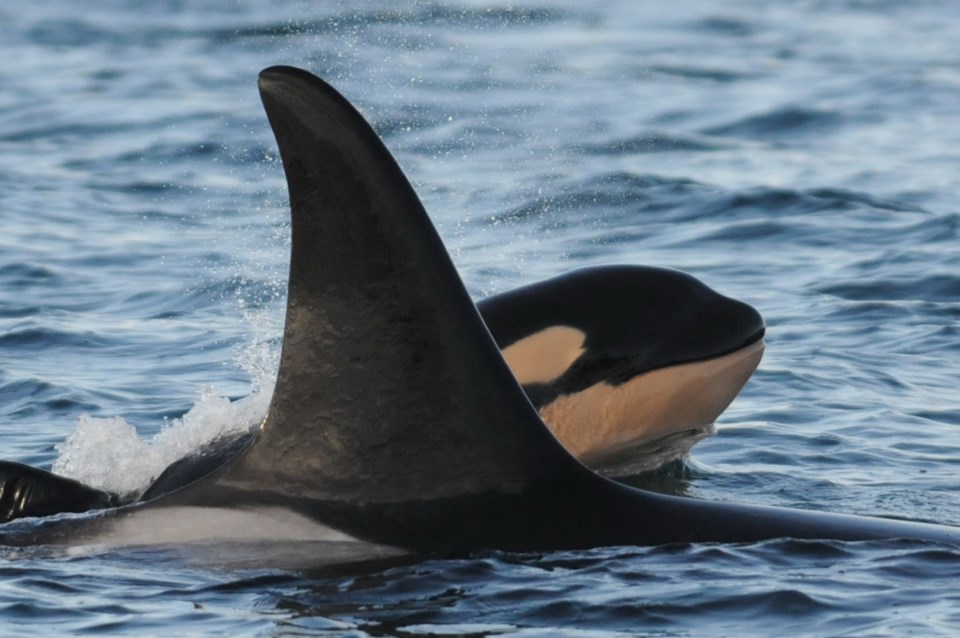An investigation into the death of a baby killer whale that absolved Royal Canadian Navy exercises around Vancouver Island of involvement was seriously flawed, two experts claim.
“My concern is our investigation team looked the other way at negligence and misleading evidence,” said Ken Balcomb from the Center for Whale Research, based in Friday Harbor, Wash.
The report, by the U.S. National Marine Fisheries Service, was released last week, two years after the body of the bloodied and bruised whale washed up on Long Beach, Wash., on Feb. 11, 2012.
The three-year-old whale belonged to the southern resident L-pod family. It was named L-112, and was sometimes called Victoria or Sooke as it was first spotted locally.
The southern residents are listed as an endangered species by the U.S. and Canada with protected habitats around the Island and Washington.
At the time the whale washed ashore, advocates called into question sonar and explosives activities of the Esquimalt-based destroyer HMCS Ottawa off southern Vancouver Island just days before.
The investigation determined the whale was killed by blunt-force trauma four to 10 days before it was stranded but the nature and cause remain mysterious. There was extensive subcutaneous bruising but no broken bones or skull fractures.
The report cleared the Canadian navy, saying its exercises were too far away to be a factor in the whale’s death.
But Balcomb said the report ignored obvious flaws in evidence provided by the navy, namely conflicting accounts of where its ships were at what time during the sonar and blasting exercises.
He cited acoustic evidence of whales in the same protected corridors that sonar pings and explosions were recorded underwater. The latter most likely came from the documented navy exercises, he said. This included dropping 1.4-kilogram charges into the water to simulate battle and mid-frequency sonar over three days and locations about 80 to 90 nautical miles from the entrance to Juan de Fuca Strait.
“I would be very concerned about this type of activity and sonar in critical habitat,” Balcomb said.
His other complaints about the report include its failure to look at the caring behaviour of killer whales, which can carry their dead for days and long distances, as well as scientific evidence that L-112’s injuries were consistent with blast trauma.
Balcomb wants the National Marine Fisheries Service to reopen its investigation.
“I consider the evidence presented in the NMFS report to be selected and filtered to depict a preferred hypothetical scenario, rather than one that may be more realistic,” Balcomb wrote to Brent Norberg, one of the lead investigators.
Norberg said he received Balcomb’s request and forwarded it to his fellow investigators for consideration but did not say whether the investigation would be reopened.
Scott Veirs, an environmental biologist with Beam Reach marine science school, said he supported Balcomb’s call to reopen the investigation.
“The Canadian navy has marine mitigation measures in place that look very sound. But were they followed?” Veirs said, citing discrepancies in the investigation. The navy said lookouts had a clear view of the area in which their exercises took place but did not disclose the time of day.
“The explosions recorded were three hours before sunrise. How can you see whales then?” Veirs noted.
He called for full disclosure on what exact charges and sonar were put in the water, when and at what locations.
The nautical miles and map of the exercises the navy provided investigators do not match up, Veirs said.
Navy public affairs did not respond to requests for comment.
Veirs said the investigation was crucial as the U.S. military looks to expand activities in the Salish Sea.
In March, Canada released a draft of its action plan on northern and resident killer whales which determined that human activity does not prevent the recovery of resident whales.
> The full report is available HERE



